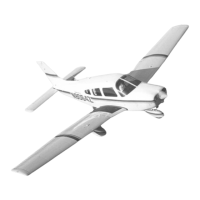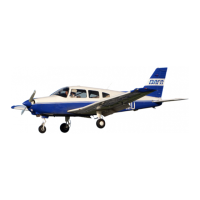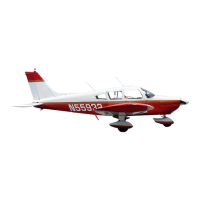PIPER AIRCRAFT, INC.
PA-28-161, WARRIOR III
MAINTENANCE MANUAL
PAGE 8
Nov 30/06
1I4
12-10-00
4. Brak
e
System
The brake system incorporates a hydraulic fluid reservoir through which the brake system is periodically
serviced. Fluid is drawn from the reservoir by the brake cylinders to maintain the volume of fluid required
for maximum braking efficiency. Spongy brake pedal action is often an indication that the brake fluid
reservoir is running low on fluid. Instructions for filling the reservoir are given in Filling Brake Cylinder
Reservoir, below. When found necessary to accomplish repairs to any of the brake system components,
or to bleed the system, see 32-40-00.
A. Filling Brake Cylinder Reservoir
The brake cylinder reservoir is located on the left side of the firewall in the engine compartment. It
should be checked at every 50 hour inspection and replenished as necessary. Fill with MIL-H-5606
fluid to level marked on reservoir. No brake adjustment is necessary, though they should be
checked periodically per instructions given in 32-40-00.
B. Draining Brake System
(1) Connect a hose to bleeder fitting on the bottom of the cylinder.
(2) Place other end of hose in a suitable container.
(3) Open bleeder fitting and slowly pump hand brake lever and appropriate brake pedal until fluid
ceases to flow.
(4) Clean brake system by flushing with denatured alcohol.
5. Tires
The airplane may be equipped with either tubed or tubeless tires.
Tubeless tires are designed to permit any air or nitrogen that is trapped in the cords or that diffuses
through the liner to escape through special sidewall vents. This venting prevents pressure build-up within
the cord body which might cause tread, sidewall or ply separation. Discounting tire growth after initial
inflation, once the tire has been inflated, the maximum permissible pressure drop due to diffusion is 5%
in any 24 hour period.
Vent holes penetrate the sidewall rubber to, or into, the cord body and may vary in size, depth and angle.
Therefore, the amount of diffusion through these holes will vary.
When water or a soap solution is brushed over the outside of an inflated tubeless tire, bubbles form.
Some vents may emit a continuous stream of bubbles. Others may produce intermittent bubbles. And
some may not bubble at all. This variety is normal and does not mean that there is anything wrong with
the tire. In fact, as long as a tubeless tire is inflated, there will be some diffusion from the vents. When
the loss rate exceeds 5% in 24 hours, recheck for possible injuries. Vents should remain open, so check
periodically to make sure they have not been covered over or closed by tire paint or spilled solvent. And
since vents may be covered during retreading, check for evidence that your retreads have been
revented.
A. Several basic characteristics of tubeless aircraft tires may be mistaken for problems:
(1) Tire growth in the first 12 to 24 hours after inflation will result in a seemingly severe pressure
drop. Simply inflate, wait for another 24 hours, then check pressure. It will probably be within
specs.
(2) Make sure that initial inflation is to recommended operating pressure to ensure full tire growth.
(3) It is normal for tubeless tires to show a small amount of pressure leakage throughout the life of
the tires.

